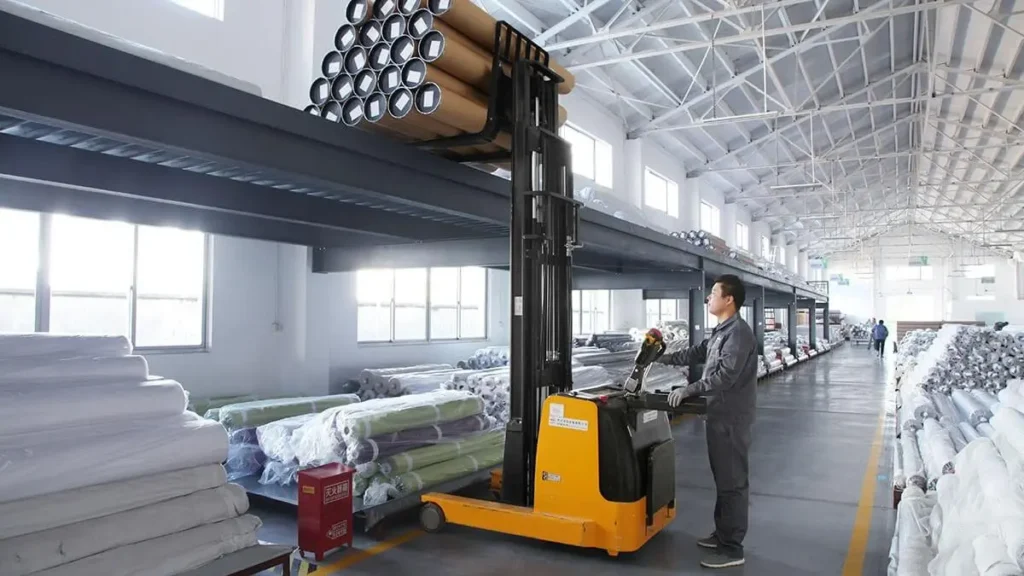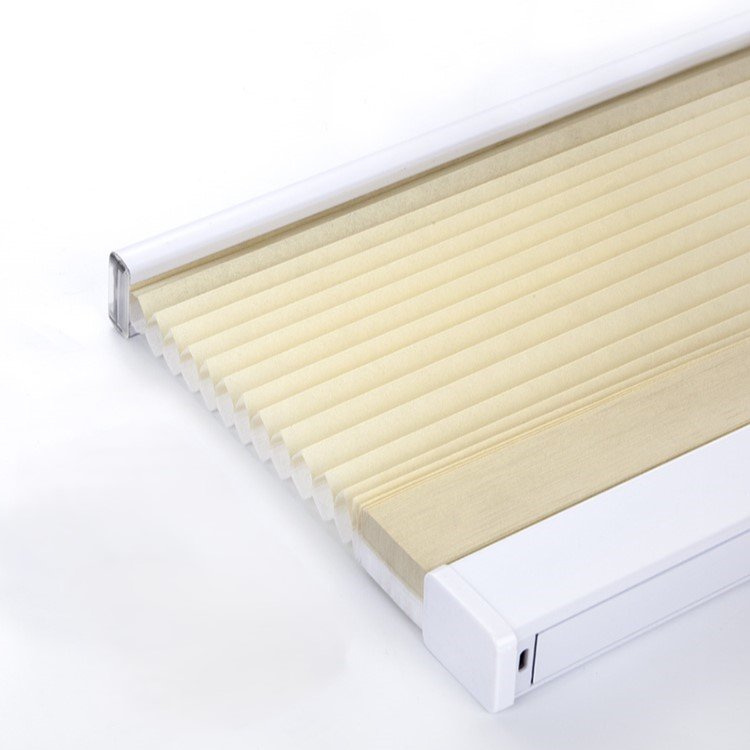The cost of motorized blinds for businesses in 2025 is always changing. Many things affect the price, not just the blind itself. This guide helps me explain the factors that drive costs.
The cost of commercial motorized blinds in 2025 is driven by blind type, motor (wired, battery, silent), control complexity, fabric, and project scale. Shadesmart optimizes cost-efficiency by leveraging product range and expertise, delivering tailored, budget-friendly solutions that meet commercial specifications, performance, and reliability.
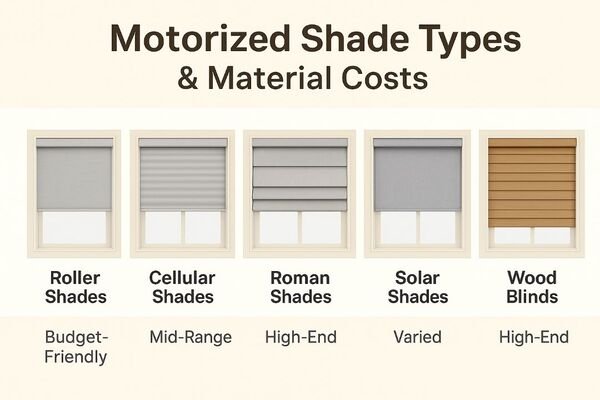
I know that understanding the cost of motorized blinds for commercial projects is a key part of my role in helping clients make smart decisions. While the initial investment can seem higher than manual options, the long-term benefits are substantial. This guide helps me break down the core components that contribute to the cost and highlight the value motorized blinds bring to any business.
What are the core components contributing to the cost of commercial motorized blinds?
Are you wondering what parts actually make up the cost of motorized blinds for your business? It is more than just the fabric.
The core components contributing to the cost of commercial motorized blinds include the blind type (e.g., roller, cellular, Venetian), individual blind dimensions, the selected motor (wired, battery, low-voltage), the power source infrastructure, the chosen control system, and the specific fabric material and its performance features.
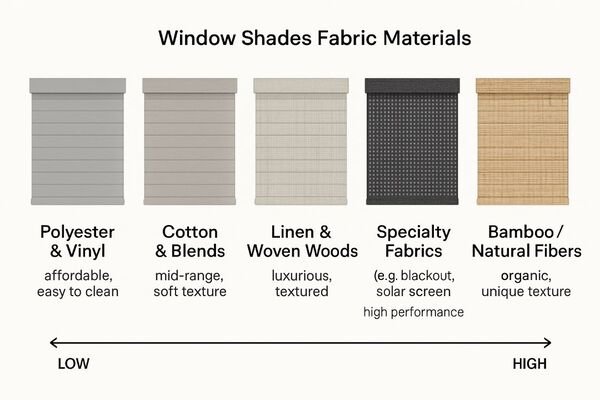
From my experience, when I analyze the cost of commercial motorized blinds, I break it down into several core components. First, the type of blind itself is a significant factor. A simple motorized roller shade is typically less expensive than a motorized cellular shade or a specialized motorized Venetian blind. Also, the size of each individual blind, both width and height, directly impacts the material cost of the fabric and the necessary motor strength. Second, the motor is the heart of the system. Motors vary in cost based on their type (e.g., battery-powered, low-voltage DC, line-voltage AC), brand, and features like noise level (whisper-quiet motors are more premium) or speed. The power source infrastructure for wired motors, including wiring and electrical work, adds to the initial installation cost. Third, the control system plays a crucial role in pricing. Basic wall switches or handheld remotes are the most affordable, but integration with a centralized building management system (BMS), smart home platforms (like Control4, Crestron, or Lutron), or even app-based controls will significantly increase the overall investment due to additional hardware, software, and programming. Fourth, the fabric selection impacts cost. Performance fabrics like those that are fire-rated (NFPA 701, important for commercial projects), energy-efficient (solar screens), or acoustic will be pricier than standard decorative fabrics. Finally, any custom features, such as specialized headrails, side channels for blackout, or unique mounting brackets, will also add to the final cost. Shadesmart's consultation covers these details.
| Cost Component | Description | Impact on Overall Cost |
|---|---|---|
| Blind Type | Roller, cellular, zebra, Venetian, etc. | Specialized or complex blind types generally cost more. |
| Blind Dimensions | Individual width and height of each blind. | Larger blinds require more material and stronger motors, increasing cost. |
| Motor Type | Battery-powered, low-voltage (DC), line-voltage (AC), brand, noise level. | Higher-end, quieter, or brand-name motors increase price. |
| Power Source Infrastructure | Wiring for wired motors, power supplies, transformers. | Adds to initial installation cost for wired systems. |
| Control System | Remote, wall switch, app control, smart home/BMS integration. | Sophisticated integration systems significantly raise price. |
| Fabric Selection | Standard vs. performance fabrics (fire-rated, solar screen, blackout), aesthetic quality. | Performance or premium aesthetic fabrics increase cost. |
| Custom Features/Hardware | Specialized headrails, side channels, custom mounting. | Any bespoke elements add to overall cost. |
| Installation Complexity | Height, accessibility, number of blinds, wiring difficulty. | Difficult or large-scale installations increase labor costs. |
How do different motor types and control systems affect the overall investment?
Are you trying to figure out how choosing different motors and ways to control your blinds changes the total money you need to spend? These choices matter a lot.
Different motor types and control systems significantly affect the overall investment. Motor types vary by power source (battery vs. wired), noise level (standard vs. silent), and brand, impacting initial cost and installation. Control systems range from simple remotes to complex smart-building integrations, with each level adding cost through hardware, software, and programming requirements.
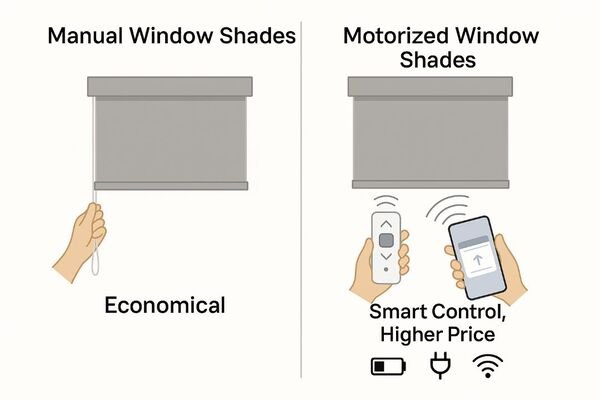
I know that the choice of motor type and control system significantly influences the overall investment in commercial motorized blinds. These are often the most critical decisions affecting both performance and budget. Regarding motor types, the primary distinction is the power source. Battery-powered motors generally have a lower upfront installation cost because they require no electrical wiring, making them ideal for retrofits. However, there is the ongoing small cost and inconvenience of periodic battery replacement. Wired motors (low-voltage DC or line-voltage AC) have a higher initial installation cost due to the required electrical work but offer continuous, reliable power without battery maintenance. Motor quality also varies; standard motors are functional but audible, while whisper-quiet motors, though more expensive, provide a premium experience vital for hotels or executive offices. Shadesmart offers a range of high-quality, quiet motors. For control systems, the spectrum is wide. The most basic and least expensive options are handheld remotes or wall switches, offering simple individual or group control. Moving up in complexity, app-based controls via a gateway provide greater flexibility and scheduling. The highest investment comes with integration into a Building Management System (BMS) or advanced smart home platforms like Control4, Crestron, or Lutron. These systems centralize control, enable complex scheduling, and allow for integration with other building systems (HVAC, lighting), offering advanced automation and energy management benefits. The cost here includes not only the control interface hardware but also the software and programming expertise required for seamless integration.
| Component | Impact on Initial Investment | Impact on Performance & Features |
|---|---|---|
| Battery Motors | Lower installation cost (no wiring), motor cost varies by brand/power. | Convenience, wireless, requires periodic battery replacement. |
| Wired Motors (Low-Voltage) | Higher installation cost (wiring, transformer), motor cost varies. | Reliable, continuous power, no battery maintenance, quieter operation possible. |
| Wired Motors (Line-Voltage) | Highest electrical installation cost, higher motor cost for stronger operation. | Most powerful, for very large/heavy blinds, reliable, robust. |
| Standard Noise Motors | Lower motor cost. | Audible operation, acceptable in many commercial settings. |
| Whisper-Quiet Motors | Higher motor cost. | Near-silent operation, essential for luxury/noise-sensitive spaces. |
| Basic Control (Remote/Switch) | Minimal additional cost for hardware. | Simple individual or group control. |
| App-Based Control (Gateway) | Mid-tier additional cost (gateway device, app setup). | Greater flexibility, scheduling, remote access via smartphone/tablet. |
| Smart System/BMS Integration | Highest additional cost (interfaces, software, programming, expertise). | Centralized control, advanced automation, energy management, multi-system integration. |
What is the long-term value proposition of automated shading for businesses?
Are you wondering if paying more for automated shades now will actually help your business in the long run? Yes, it brings many benefits that save money and make things better.
The long-term value proposition of automated shading for businesses includes significant energy savings from optimized daylighting and temperature control, enhanced occupant comfort and productivity, increased building security and privacy, extended lifespan of interior furnishings due to UV protection, and elevated property aesthetic and value, offering a strong ROI.

I know that demonstrating the long-term value proposition of automated shading is crucial, as it often justifies the initial investment for my B2B clients. First, significant energy savings are a primary benefit. Automated blinds can be programmed to respond to solar intensity, automatically lowering to block heat gain on sunny days and raising to allow passive solar heating in cooler months. This active management minimizes reliance on HVAC systems, leading to substantial reductions in heating and cooling costs over the building's lifespan. Shadesmart's solutions are designed for this efficiency. Second, enhanced occupant comfort and productivity are invaluable. By eliminating harsh glare and optimizing natural light levels, automated shades create a more comfortable and visually pleasing environment. This can reduce eye strain, improve concentration, and lead to increased satisfaction and productivity for employees or guests. Third, increased building security and privacy are notable advantages. Automated shades can close at programmed times, creating the appearance of occupancy and deterring potential intruders, while also providing privacy for sensitive areas. Fourth, the extended lifespan of interior furnishings offers tangible savings. Automated blinds effectively block harmful UV rays, protecting carpets, furniture, and artwork from fading and degradation, thereby reducing the need for costly replacements. Finally, automated shading elevates the property's aesthetic and value. It projects a modern, sophisticated image and contributes to green building certifications (like LEED), thereby increasing marketability, rental yields, and overall property value. These combined benefits paint a clear picture of a strong return on investment.
| Value Proposition | Description | Long-Term Business Benefit |
|---|---|---|
| Energy Savings | Optimized management of solar heat gain and loss, reduced HVAC usage. | Substantial reduction in utility bills, lower operational costs. |
| Enhanced Comfort & Productivity | Glare control, optimized daylight levels, consistent indoor temperature. | Increased employee satisfaction, improved focus, fewer complaints. |
| Increased Security & Privacy | Automated closing provides privacy and creates perceived occupancy. | Deters intruders, secures sensitive areas. |
| Interior Asset Protection | Blocking harmful UV rays protects furniture, flooring, and artwork. | Extends lifespan of interior furnishings, reduces replacement costs. |
| Elevated Property Value | Modern amenity, sophisticated aesthetic, contribution to green building goals. | Increased marketability, higher rental income or resale value. |
| Operational Efficiency | Eliminates manual adjustment across numerous windows. | Saves labor costs, frees up staff for critical tasks. |
| Health & Well-being | Maximized natural light, reduced reliance on artificial lighting. | Contributes to occupant well-being (e.g., circadian rhythm). |
How can Shadesmart help optimize cost-efficiency for large-scale motorized blind projects?
Are you trying to get the best value for your money on a big motorized blind project? Shadesmart has ways to make your budget work harder.
Shadesmart optimizes cost-efficiency for large-scale motorized blind projects by providing transparent pricing, offering expert value engineering and scalable solutions, leveraging competitive wholesale pricing, ensuring durable high-ROI product selection, and providing comprehensive project management from consultation to installation.

I know that for B2B clients tackling large-scale motorized blind projects, optimizing cost-efficiency without sacrificing quality or performance is paramount. Shadesmart approaches this challenge systematically. First, we provide transparent pricing and detailed cost breakdowns. This means every component, from motors and fabrics to control systems and installation, is itemized. This clarity empowers clients to make informed decisions and quickly see where costs can be adjusted. Second, our team offers expert value engineering and scalable solutions. For instance, we might recommend premium, whisper-quiet motors for client-facing areas while suggesting more economical, yet still reliable, motors for less critical back-office spaces. This strategic allocation of budget ensures maximum impact where it matters most. Third, leveraging our extensive factory partnerships and high volume of orders, Shadesmart secures competitive wholesale pricing. These cost savings are directly passed on to our B2B clients, significantly improving their project margins for large-scale endeavors. Fourth, we focus on providing durable, high-ROI product selections. By specifying robust fabrics and reliable motor systems that have a long lifespan, we help clients minimize future maintenance and replacement costs, ensuring their initial investment delivers sustained value. Finally, Shadesmart offers comprehensive project management. Our team oversees the entire process, from initial consultation and design to fabrication, logistics, and installation support, ensuring adherence to budget and timeline. This streamlined approach minimizes errors, reduces delays, and ultimately controls costs for complex commercial projects.
| Shadesmart's Strategy | Description | Direct Benefit for Our Partners |
|---|---|---|
| Transparent Pricing | Detailed, itemized cost breakdowns for all components and services. | Clear understanding of expenses, facilitates precise budget management. |
| Expert Value Engineering | Strategic recommendations for optimizing product features vs. cost. | Achieves project goals effectively within budgetary limits. |
| Scalable Solutions | Offering a range of options from premium to more economical, yet reliable, choices. | Flexibility to tailor solutions, allocating budget for maximum impact. |
| Competitive Wholesale Pricing | Leveraging bulk purchasing power and established factory relationships. | Significant cost savings for large-scale commercial orders. |
| Durable High-ROI Product Selection | Guiding clients toward products that offer longevity and performance. | Reduces long-term maintenance/replacement costs, maximizes return on investment. |
| Comprehensive Project Management | End-to-end oversight from design to delivery and installation support. | Streamlined process, minimizes delays, controls overall project costs. |
| Post-Installation Support | Ongoing technical assistance and warranty management. | Ensures long-term satisfaction and protects the investment. |
Conclusion
Motorized blind costs depend on blind type, motor, control system, fabric, and project scope. Different motors and controls impact investment significantly. Automated shading offers long-term value through energy savings, comfort, and enhanced security. Shadesmart optimizes cost-efficiency for large projects with transparent pricing, value engineering, wholesale rates, and comprehensive project management.
